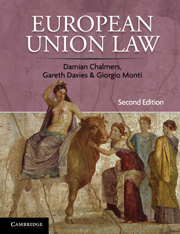Book contents
- Frontmatter
- Contents
- Map
- Preface
- Abbreviations
- Table of Cases
- Table of Treaties, Instruments and Legislation
- Table of Equivalents
- Electronic Working Paper Series
- 1 European Integration and the Treaty on European Union
- 2 The EU Institutions
- 3 Union Law-making
- 4 The EU Judicial Order
- 5 The Authority of EU Law
- 6 Fundamental Rights
- 7 Rights and Remedies in National Courts
- 8 Infringement Proceedings
- 9 Governance
- 10 Judicial Review
- 11 EU citizenship
- 12 EU Law and Non-EU Nationals
- 13 Equal Opportunities Law and Policy
- 14 EU Criminal Law
- 15 External Relations
- 16 The Internal Market
- 17 Economic and Monetary Union
- 18 The Free Movement of Goods
- 19 The Free Movement of Services
- 20 The Pursuit of an Occupation in Another Member State
- 21 Trade Restrictions and Public Goods
- 22 EU Competition Law: Function and Enforcement
- 23 Antitrust and Monopolies
- 24 State Regulation and EU Competition Law
- Index
13 - Equal Opportunities Law and Policy
- Frontmatter
- Contents
- Map
- Preface
- Abbreviations
- Table of Cases
- Table of Treaties, Instruments and Legislation
- Table of Equivalents
- Electronic Working Paper Series
- 1 European Integration and the Treaty on European Union
- 2 The EU Institutions
- 3 Union Law-making
- 4 The EU Judicial Order
- 5 The Authority of EU Law
- 6 Fundamental Rights
- 7 Rights and Remedies in National Courts
- 8 Infringement Proceedings
- 9 Governance
- 10 Judicial Review
- 11 EU citizenship
- 12 EU Law and Non-EU Nationals
- 13 Equal Opportunities Law and Policy
- 14 EU Criminal Law
- 15 External Relations
- 16 The Internal Market
- 17 Economic and Monetary Union
- 18 The Free Movement of Goods
- 19 The Free Movement of Services
- 20 The Pursuit of an Occupation in Another Member State
- 21 Trade Restrictions and Public Goods
- 22 EU Competition Law: Function and Enforcement
- 23 Antitrust and Monopolies
- 24 State Regulation and EU Competition Law
- Index
Summary
INTRODUCTION
The EEC Treaty of 1957 provided limited grounds for developing European equal opportunities law, but there has been a dramatic increase since then, in particular as a result of judicial activism and the incorporation of Article 19 TFEU (ex Article 13 EC) by the Amsterdam Treaty. EU law now regulates discrimination on grounds of sex, gender, race, ethnic origin, religion or belief, sexual orientation, age and disability. In this chapter we examine the key legislative provisions, the motivation for the European Union to intervene, and the evolution of the Union's equal opportunities policy.
Section 2 explores three issues to place the law in a wider context. First we ask why the Union needs an equal opportunities policy. On the one hand, banning discrimination is a necessary complement to the economic project of creating an internal market: discrimination reduces economic welfare and so must be prohibited. On the other hand, the tasks of the Union are wider: to enhance the rights of its citizens, irrespective of economic considerations. The Court of Justice has indicated a preference for the second view, most controversially in its Mangold judgment. Secondly, we consider what kind of anti-discrimination policy the European Union is developing. One model sees discrimination law as promoting equality of opportunities, and the other suggests that discrimination laws can be successful only if they yield equality of results.
- Type
- Chapter
- Information
- European Union LawCases and Materials, pp. 534 - 580Publisher: Cambridge University PressPrint publication year: 2010

